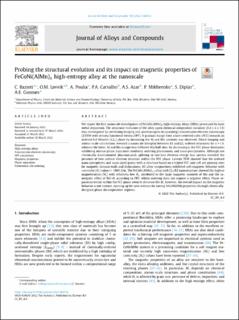| dc.contributor.author | Bazioti, Kalliopi | |
| dc.contributor.author | Løvvik, Ole Martin | |
| dc.contributor.author | Poulia, Anthoula | |
| dc.contributor.author | Almeida Carvalho, Patricia | |
| dc.contributor.author | S. Azar, Amin | |
| dc.contributor.author | Mikheenko, Pavlo | |
| dc.contributor.author | Diplas, Spyridon | |
| dc.contributor.author | Gunnæs, Anette Eleonora | |
| dc.date.accessioned | 2022-08-16T10:14:10Z | |
| dc.date.available | 2022-08-16T10:14:10Z | |
| dc.date.created | 2022-03-28T01:29:19Z | |
| dc.date.issued | 2022 | |
| dc.identifier.citation | Journal of Alloys and Compounds. 2022, 910 1-12. | en_US |
| dc.identifier.issn | 0925-8388 | |
| dc.identifier.uri | https://hdl.handle.net/11250/3012058 | |
| dc.description.abstract | We report the first nanoscale investigation of FeCoNi(AlMn)x high-entropy alloys (HEAs) processed by laser metal deposition. The structural evolution of the alloy upon chemical composition variation (0.2 ≤ x ≤ 1.5) was investigated by combining imaging and spectroscopies in (scanning) transmission electron microscopy (S)TEM with density functional theory (DFT). A gradual change from a face-centered cubic (FCC) towards an ordered full-Heusler (L21) phase by increasing the Al and Mn contents was observed. Direct imaging and atomic-scale calculations revealed a nanoscale interplay between B2 and L21 ordered structures for x = 1.5, wherein the latter, Al and Mn occupy two different Wyckoff sites. By decreasing x, the FCC phase dominates exhibiting intense phase separation tendency, ordering phenomena, and nano-precipitation. Although not chemically discriminated, plasmon-peak splitting in low-loss electron energy loss spectra revealed the presence of two valence electron densities within the FCC phase. Lorentz TEM showed that the ordered nano-precipitates and nano-sized grains with a structure based on a tripled FCC unit cell are pinning-sites for magnetic domain walls and dislocations. All alloy compositions exhibited soft-magnetic behavior with coercivity (Hc) values< 1000 A/m. The FeCoNi(AlMn)1.5 alloy with L21/B2 nanostructure showed the highest magnetization (Ms) with relatively low Hc, attributed to the large magnetic moment of Mn and the synergistic effect of Mn-Al according to DFT, whilst ordering does not impose a negative effect. Phase separation trends within the FCC phase seem to decrease the Ms however, the overall impact on the magnetic behavior is not intense, opening up for new avenues for tuning FeCoNiAlMn properties through chemically-designed phase decomposition regimes. | en_US |
| dc.language.iso | eng | en_US |
| dc.publisher | Elsevier | en_US |
| dc.rights | Navngivelse 4.0 Internasjonal | * |
| dc.rights.uri | http://creativecommons.org/licenses/by/4.0/deed.no | * |
| dc.subject | Preferential site ordering | en_US |
| dc.subject | Phase separation | en_US |
| dc.subject | Magnetic properties | en_US |
| dc.subject | DFT calculations | en_US |
| dc.subject | Transmission electron microscopy | en_US |
| dc.subject | High-entropy alloys | en_US |
| dc.title | Probing the structural evolution and its impact on magnetic properties of FeCoNi(AlMn)x high-entropy alloy at the nanoscale | en_US |
| dc.title.alternative | Probing the structural evolution and its impact on magnetic properties of FeCoNi(AlMn)x high-entropy alloy at the nanoscale | en_US |
| dc.type | Peer reviewed | en_US |
| dc.type | Journal article | en_US |
| dc.description.version | publishedVersion | en_US |
| dc.rights.holder | © 2022 The Author(s). Published by Elsevier B.V | en_US |
| dc.source.pagenumber | 1-12 | en_US |
| dc.source.volume | 910 | en_US |
| dc.source.journal | Journal of Alloys and Compounds | en_US |
| dc.identifier.doi | 10.1016/j.jallcom.2022.164724 | |
| dc.identifier.cristin | 2012851 | |
| dc.relation.project | Norges forskningsråd: nn2615k | en_US |
| dc.relation.project | Norges forskningsråd: 197405 | en_US |
| dc.relation.project | Norges forskningsråd: 287979 | en_US |
| dc.source.articlenumber | 164724 | en_US |
| cristin.ispublished | true | |
| cristin.fulltext | original | |
| cristin.qualitycode | 1 | |

